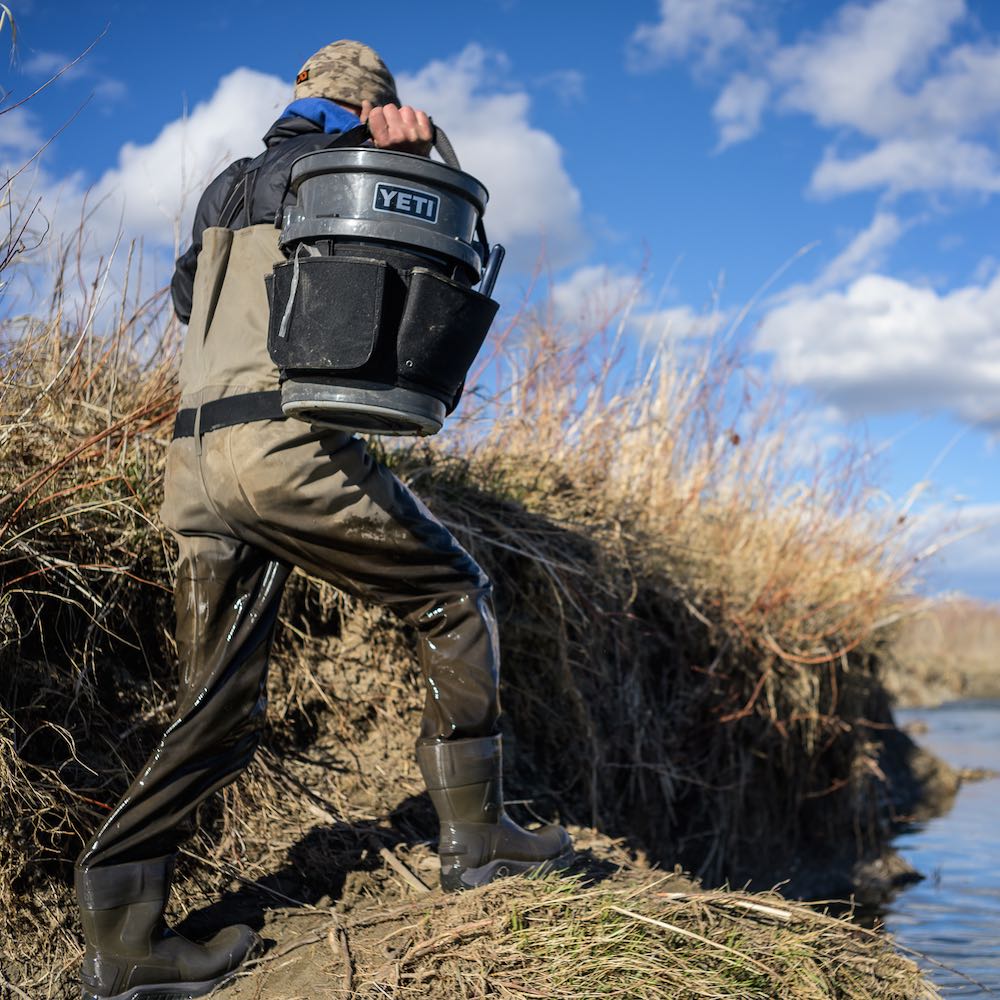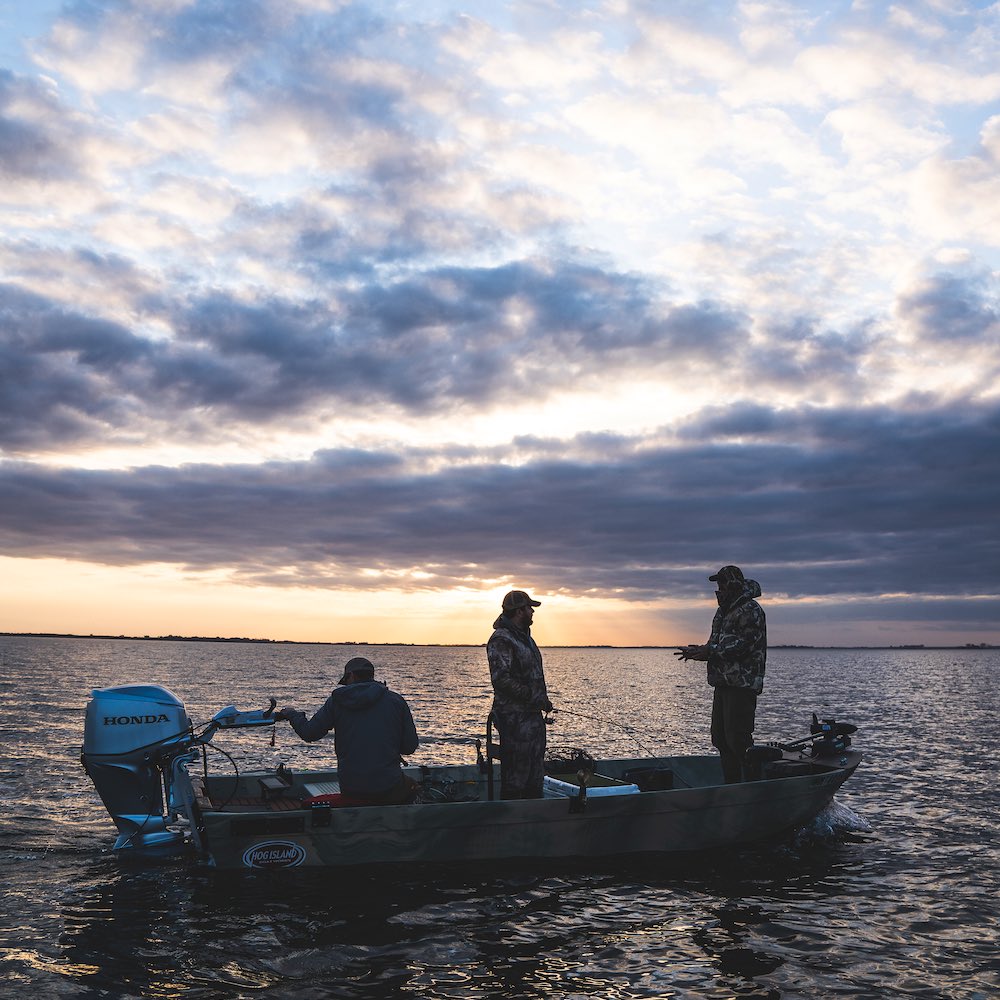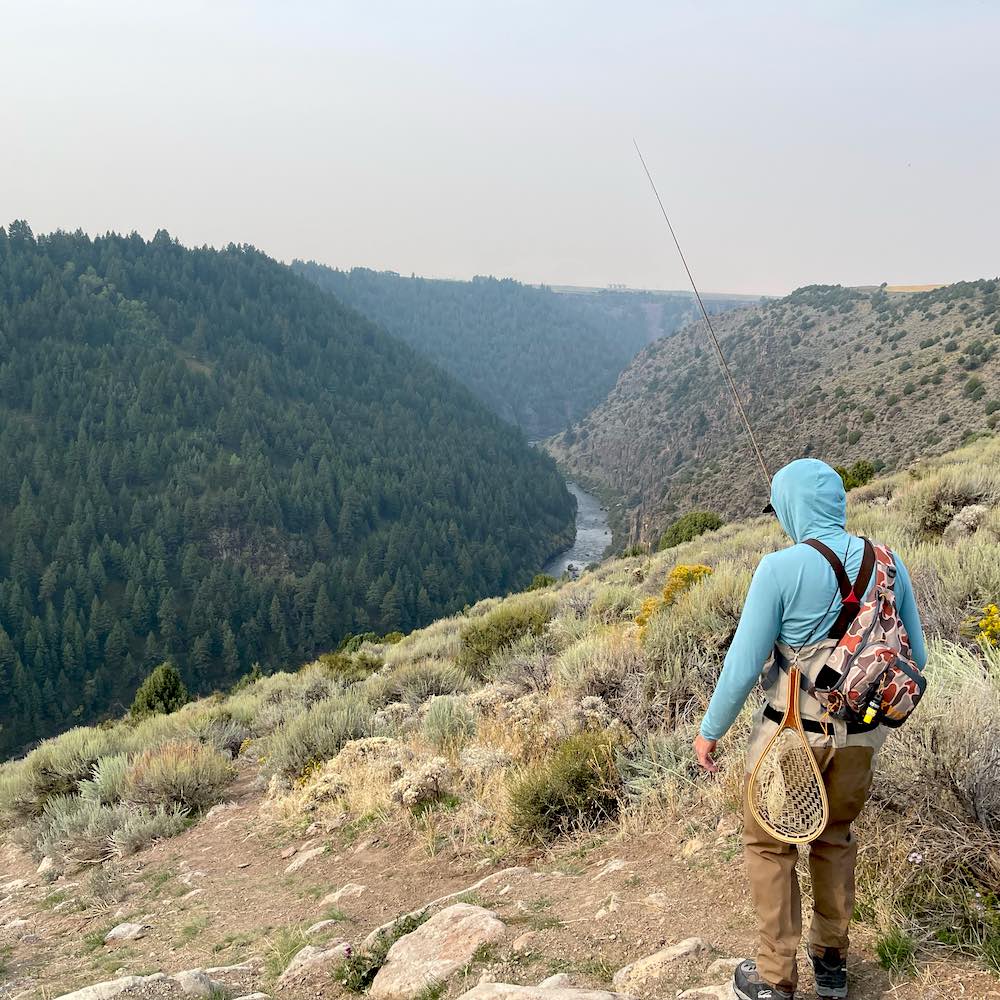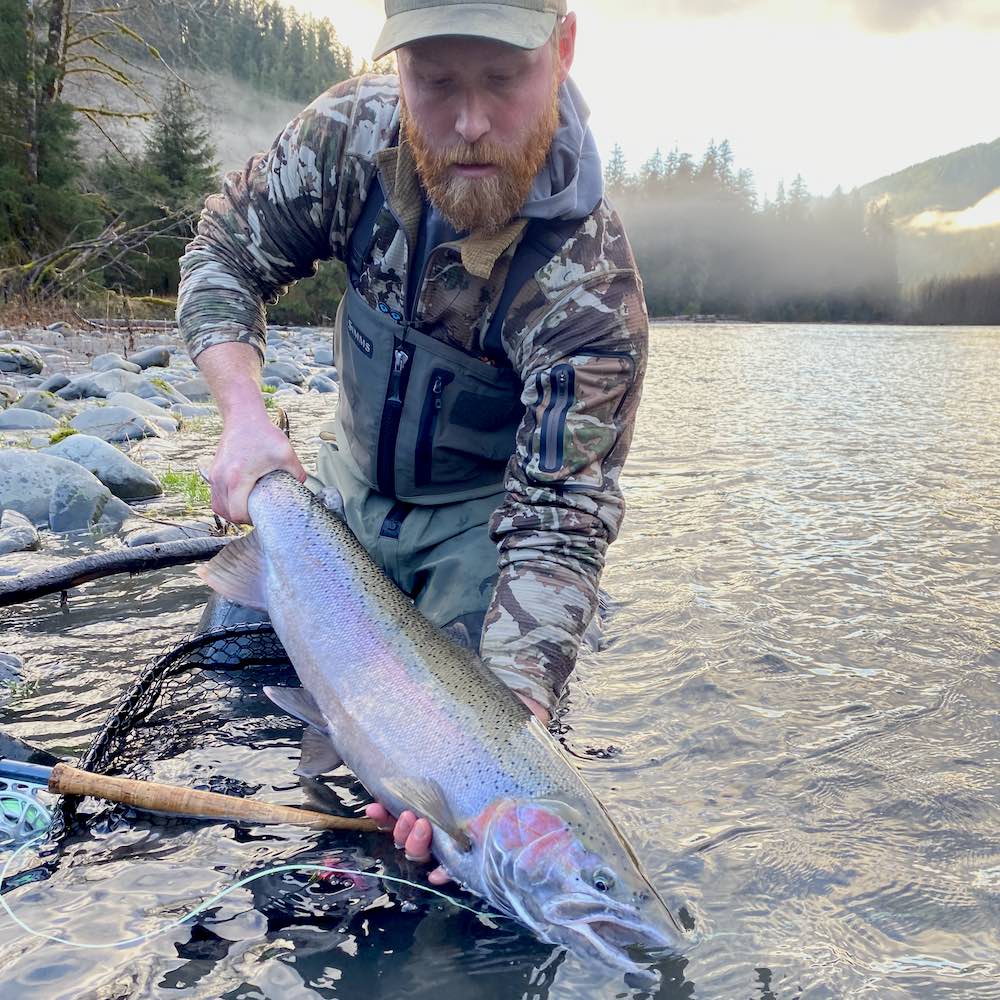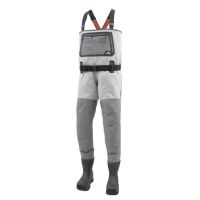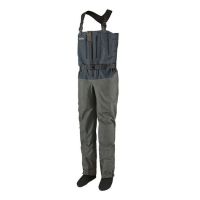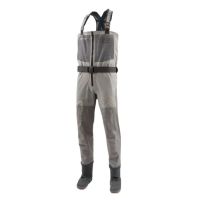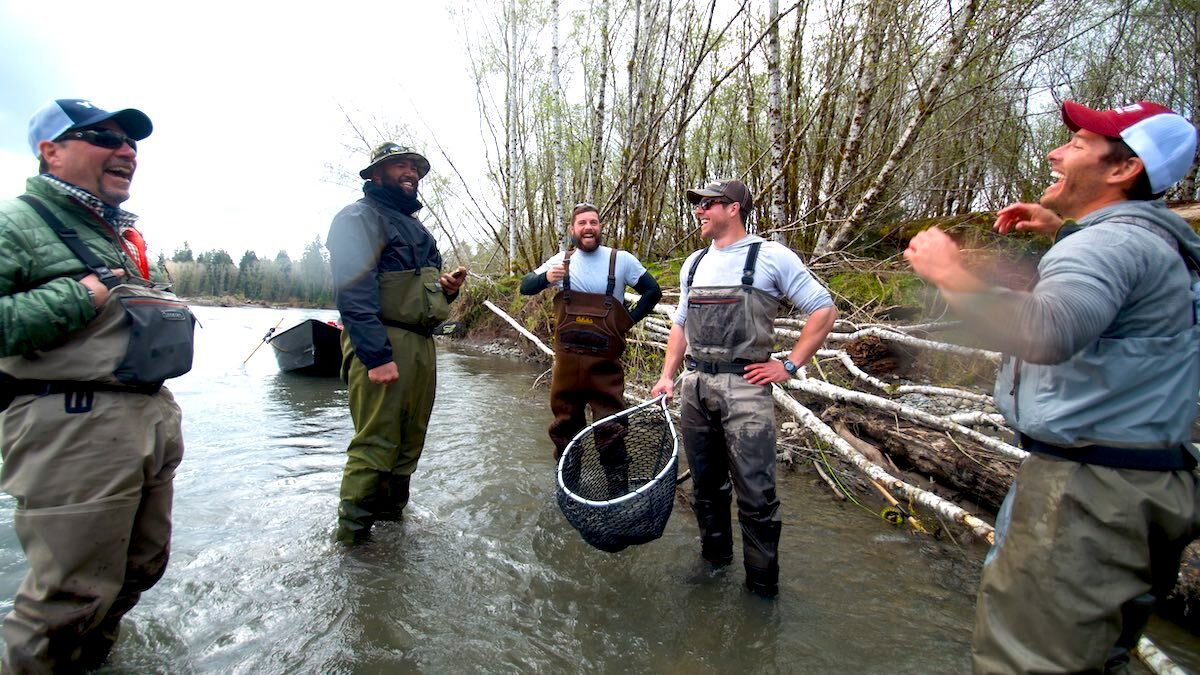
Where I’m from, you’re not really an angler until you have a decent pair of waders. In the Pacific Northwest and many other regions, you need to be able to get comfortable standing in chilly water if you’re going to catch anything outside of July and August. Whether that’s wading deep in glacial torrents for Chinook salmon or hacking through the cattails to find untouched prespawn bass, these leg coverings are simply part and parcel of being a serious fisherman. The same could be said for hunters as well.
Out in winter steelhead camp, we basically live in our waders. It’s often nearly as wet outside the river as in it. Add mud and devil’s club and there aren’t many other leg coverings that do better. This puts an emphasis on quality and construction of the waders you choose—not to mention a need to actually enjoy having them on. Waders have improved lightyears since I was a kid, but the wrong pair will still leave you swampy and chapped. Here’s how to find a setup that works for you and your sporting needs.
Jump to: The Fishing Waders We Use
What We Look for in a Good Fishing Waders
Except for the most extreme southern reaches of the United States, you can find waders in the garage of darn near every professional fishing guide. This gear may be less important for folks primarily based on boats, but lots of folks still like to have them for foul weather, trailering, or emergencies. Types of waders will vary across regions and pursuits too, but the four factors below shape how to approach the decision.
- Durability
- Materials
- Fit
- Function
The Fishing Waders We Use
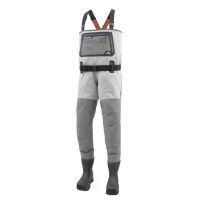 Simms G3 Vibram Sole Bootfoot Waders
Steve's Pick
|
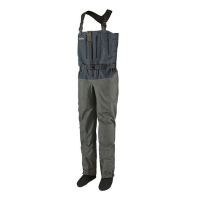 Patagonia Swiftcurrent Expedition Zip-Front
Cal's Pick
|
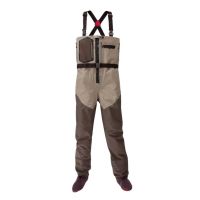 Redington Sonic Pro HDZ Waders
Mark's Pick
|
 Simms G4Z Stockingfoot Waders
Sam's Pick
|
|
|---|---|---|---|---|
| Highlight | Best Bootfoot Wader | Most Versatile Wader | Best Value Front-Zip | Most Durable Wader |
| Best For | Boat fishing, hunting, trapping, crossing streams, shorter hikes | Hiking, cold weather, multi-day excursions, hunting | Hiking, warmer weather, hunting | Hiking, cold weather, multi-day excursions, hunting |
| Key Features | Heavy-duty built-in boots, big reach-through pocket | Full-front zipper, single-seam construction, seven pockets | Full-front zipper, flip-out waterproof phone pocket | Full-front zipper, air-mesh suspenders, fleece-lined handwarmer pockets |
| Weight | 8.5 lbs | 4.1 lbs (without boots) | 2.95 lbs (without boots) | 4.1 lbs (without boots) |
| Material | Gore-Tex Pro Shell, 3-layer upper, 4-layer legs | H2No Performance 4-layer shell | 4-layer proprietary breathable construction | Gore-Tex Pro Shell, 3-layer upper, 4-layer legs |
| Price | $749* | $749* | $599* | $899* |
| Field Notes | Field Notes | Field Notes | Field Notes |
What Makes A Good Pair of Fishing Waders
1. Durability
Waders leak. Get used to it. How quickly they begin to leak, however, can vary widely between models and brands. It also somewhat depends on how you treat the gear. Yes, sometimes you need to smash through the brush to reach that remote rainforest creek but bear in mind that waders aren’t built out of chainmail. An errant barbed wire spike will open up every pair of waders, every time. Washing your boots on a regular basis will also extend the life of your waterproof material and seams—not to mention keeping you from accidentally transporting aquatic invasives between waterways. It's also a good idea to learn how to simply fix wader leaks yourself. Here's a good resource.
Disclaimers aside, you will see a big difference in durability between materials, models, and brands. My dad once got me a relatively cheap pair of neoprene waders for Christmas one year when I was probably 15. By noon the very next day, I’d punched ‘em with three holes big enough to put a finger through on a morning duck hunt with my buddies. Luckily, Dad was angrier with the wader maker than me and happily chipped in so I could get a set that might last beyond a few hours in the swamp. Fishing may put slightly less stress on your boots than duck hunting, but not a lot less in my experience.
2. Materials
Anglers and manufacturers have been making waders out of various materials for a century or more. Some of the first consumer offerings post-WWII were made of rubber or treated canvas. That progressed to PVC-coated nylon and then to neoprene, which many folks still prefer due to its warmth and stretch. But in the 1980s, a former DuPont engineer named Bill Gore started experimenting with a thin Teflon coating that he and his son Bob eventually applied to clothing, making it both waterproof and breathable. It took some time for the fishing world to adopt the revolutionary new Gore-Tex material, but K.C. Walsh started making waders out of it shortly after buying a neoprene wader company from John Simms in 1993. Expanded polytetrafluoroethylene (ePTFE) membranes, which have holes small enough to keep water molecules out but large enough to allow body heat and moisture to escape, quickly became the gold standard for both raingear and waders.
Today, many waders are built with a combination of materials. Many fishing models include ePTFE “breathable” uppers and legs welded to neoprene booties—known as “stockingfoot” waders, meant to be paired with separate wading boots. “Bootfoot” models tie breathable or neoprene uppers and legs to integrated rubber boots. That joint where the boots or stockings meet the leg material has bedeviled wader makers and wader wearers since the beginning. When you’re buying waders, look closely at the welding and protection at that interface.
Neoprene and rubberized nylon have largely disappeared from the fishing market, though they still have plenty of advocates in the hunting world. That said, some anglers still prize the insulation provided by thick neoprene or the bulletproofness of PVC-coated foulweather gear waders. But none of them likely want to walk very far in either material unless it’s darn near freezing outside. A lot more fishermen and women in cold climes prefer to [layer up with Merino wool](https://www.firstlite.com/products/mens-kiln-long-john), fleece, or down beneath their breathable waders, which allows excess heat and vapors to escape—but not straight up your face when you bend over.
3. Fit
Early waders were basically body-shaped bags with legs. Some hyper-modern designs run skin-tight enough to go on a jog up the riverbank. If you’ve got thunder thighs like me, something in the middle might be more your taste. Our crew likes waders that contour to your body shape without being constrictive in the knees, crotch, belly, or chest. You may want to emphasize your curves more than we do, but that only highlights the value of trying on different brands and sizes before buying.
Fly shops are great places to do this, but you may find each one only sells one or two brands, Simms or Patagonia, Orvis or Reddington. Even big box stores like Cabela’s or Sportsman’s Warehouse may only offer Hodgeman, Frog Togg, or proprietary brands. It may be more helpful to start with research online to find a couple manufacturers you’d like to try-companies with good customer service, solid reviews, and within your price range—then visit a store that sells them in order to try a few on. Some companies now offer a dozen or more sizes for the top-end waders, with specific inseam and torso measurements to match any body type.
4. Function
When most people say “waders” these days, they mean chest waders. That said, hip-boots and wading pants haven’t entirely vanished. My dad still loves his hippers for launching the boat and beach casting for salmon. That could be a decent option for some passive angling needs, especially if you don’t want to spend more than $100. But the fact remains that chest waders are the preference of most regular wader wearers. Most of the good options also include the ability to slide down the torso segment around your waist when it’s hot or you just aren’t wading to your pits.
Some waders today are so teched-out it almost feels like they should catch fish for you—especially at the prices they run. But with those amenities and expenditure, you’re often getting a better build and a lot of great and helpful features. Pockets are a big one, especially if you’re fishing the shoulder seasons and want to warm your hands. Some offer so much storage you barely need to bring a pack to carry gear on a hike around the lake. Zingers for hemostats and nippers, clips for attaching other gear, internal zip-lock waterproof phone pockets, knee pads, and more options are now common. Some waders now come with full-length heavy-duty waterproof front zippers for ease of entry and relief. Think about what function you need to fill and the features to get you there.
Lastly, I have to harp on one of my biggest pet peeves: wading belts. They all come with them, but folks forget or prefer not to strap up. That’s incredibly dangerous. Waders, when they fill with water, become heavy and negatively buoyant—meaning they’ll drag you down to the bottom before you can unstrap enough to get out. Plenty of anglers have drowned because of this. A wading belt is not meant as a corset or inconvenience; it’s so your legs don’t fill with water and deliver you to Davey Jones. Wear it every time and wear it snug. Numerous times I’ve pulled the casual leather belt off my jeans to give a friend who forgot their nice elastic wading belt at home.
Bootfoot vs. Stockingfoot
It’s a debate as old as modern waders themselves: integrated boots or separate. The fact of the matter is that both have advantages and disadvantages. Plenty of folks (myself included) own both types for different applications. Let’s start with bootfoot.
Waders that have the shoes and soles welded straight on to the legs are a lot easier and faster to don than waders with separate boots. No additional step, no laces to tie. Some folks say they’re warmer too because there isn’t a tight section around your ankle hindering blood flow and body heat. However, because they generally lack laces on the boot, they’re often a bit looser and sloppier than stockingfoots. That’s not much of a problem if you’re sitting in a boat most of the day, but it can create blister issues if you have to walk a ways—though that can be solved with good fit and the right sock thickness.
Stockingfoot waders are often the preference of anglers who are really wading—think slippery, rock-lined Colorado trout streams or New Jersey rip-rap jetties. Because you’re sliding the stockings into a full-on boot, and tightening it with straps or laces, you’re going to have a lot more ankle support and grip around your foot. That’s a huge deal on snotty rocks, wet logs, viscous mud, or ice. Separate wading boots can also make your kit more versatile, allowing you multiple options for soles like felt, Vibram, studs, or aluminum bars to grip slick surfaces. Again though, stockingfoots lose every time with speed and ease of getting dressed and often run a little cooler—though plenty offer very thick neoprene in the stocking to combat that.
Field notes from the MeatEater Crew
Steve's Pick
Best Bootfoot Wader
Simms Fishing Products pretty much invented breathable waders, and that history has been carried forward in large part by the long-running G3 line. They’re simple and straightforward without too many bells and whistles, but that also makes them light, easier to layer over, and applicable for the broad variety of outdoors pursuits a man like Steve Rinella engages in every year. From beaver trapping and duck hunting to clam digging and salmon fishing, a pair of these waders lives in the truck bed or boat hatch of many an all-around outdoorsman.
“I'm a big fan of Simms Vibram Sole G3 Guide Bootfoot waders for all-around hunting and fishing use,” Steve said. “They're extremely comfortable and durable, easy to take on and off, and your feet stay nice and warm even when your breaking ice on cold mornings.”
Specifications
- Best For: Boat fishing, hunting, trapping, crossing streams, shorter hikes
- Key Features: Heavy-duty built-in boots
- Weight: 4.5 lbs
- Material: Gore-Tex Pro Shell, 3-layer upper, 4-layer legs and seat
- Price: $749
Cal's Pick
Most Versatile Wader
Patagonia entered the wader game with the full force of their massive apparel juggernaut in the early 2000s. Despite some early struggles, they’ve captured a large portion of the market and helped drive innovation. Ryan Callaghan has been using their boots for years and has been especially impressed with the rugged and feature-rich new top-line offering.
“Nothing beats the ease of bootfoot waders, but if you’re booting up to do a full-on day of steelheading or something serious, those Patagonia Swiftcurrents make you feel over-prepared, like you’re ready for battle. It’s confidence building,” Cal said. “The zip front has got some real benefits, like being able to comfortably relieve yourself in the woods without putting the same amount of urine down front of wader, but also for being able to easily dig into interior layers on cold days. They’re durable and breathable and the build on them is over the top.”
Specifications
- Best For: Hiking, cold weather, multi-day excursions, hunting
- Key Features: Full-front zipper, single-seam construction, lots of pockets
- Weight: 4.1 lbs (without boots)
- Material: H2No Performance 4-layer shell
- Price: $749
Mark's Pick
Best Value Front-Zip
You might wonder what MeatEater’s whitetail hunting guru would have to say about fishing gear, but it should be known that Mark has a cabin on a famous Idaho tailwater where he spends most of the summer fly fishing. And, as a famously creative and effective deer hunter, he also uses the same boots in the fall to get him and his tree saddle back in to spots where no one else ventures. For both purposes, he’s quite fond of his Redington Sonic Pro HDZs, one of the most affordable zip-front waders available.
“These are the nicest, most feature-rich waders I've owned to date,” Mark said. “They're comfortable and seemingly pretty bomber. But what I like most is the full zip front, allowing for convenient ‘relief’ (if you know what I mean), and the zip-up handwarmer pockets hidden in the chest.”
Specifications
- Best For: Hiking, warmer weather, hunting
- Key Features: Full-front zipper, flip-out waterproof phone pocket
- Weight: 2.95 lbs (without boots)
- Material: 4-layer proprietary breathable construction
- Price: $599
Sam's Pick
Most Durable Wader
I’ve owned probably upwards of 20 pairs of waders in my lifetime. None have fit or flowed with my body and gait nearly as well as the Simms G4Zs. They’re not too tight and not too baggy, which has to be a function of the fact that they offer them in 27 different size configurations. They’re also made about five miles from my house outside of Bozeman, Montana, and I feel that’s reflected in the durability and customer care I’ve always experienced with this brand.
Just like with a good pair of pants, ergonomic and well-built waders just make your legs feel like swinging. Plenty others don’t offer that range of motion and will wear you out fast. It’s a big deal when you’re trying to get a bunch of miles up into the wilderness or down into the canyon without having to swap your wading boots for hiking boots. The G4Zs breathe great when it’s hot and keep you cozy when it’s cold. I wear them in July and January and can’t imagine what else you could ask for in a fishing wader.
Specifications
- Best For: Hiking, cold weather, multi-day excursions, hunting
- Key Features: Full-front zipper, air-mesh suspender system, zippered and fleece-lined handwarmer pockets
- Weight: 4.1 lbs (without boots)
- Material: Gore-Tex Pro Shell, 3-layer upper, 4-layer legs and seat
- Price: $899

